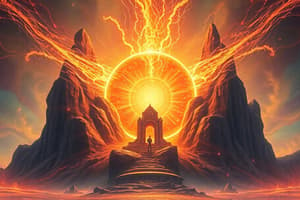Podcast
Questions and Answers
What is the primary difference between fission and fusion reactions?
What is the primary difference between fission and fusion reactions?
- Fission is more difficult to sustain than fusion.
- Fission is a spontaneous process, while fusion is induced.
- Fission releases more energy than fusion.
- Fission involves the splitting of atomic nuclei, while fusion involves the joining of nuclei. (correct)
What is the process by which the nucleus of an atom spontaneously disintegrates, resulting in more stable daughter nuclei?
What is the process by which the nucleus of an atom spontaneously disintegrates, resulting in more stable daughter nuclei?
- Nuclear transmutation
- Fusion
- Fission
- Radioactive decay (correct)
What is the purpose of nuclear medicine?
What is the purpose of nuclear medicine?
- To produce energy through fission and fusion
- To understand nuclear stability and energy release
- To induce nuclear transmutation reactions
- To study and treat various medical conditions using radioactive isotopes (correct)
What is the characteristic of fission reactions that allows them to be sustained in a nuclear reactor?
What is the characteristic of fission reactions that allows them to be sustained in a nuclear reactor?
What is the challenge in sustaining fusion reactions for long periods of time?
What is the challenge in sustaining fusion reactions for long periods of time?
Flashcards are hidden until you start studying
Study Notes
Fission and Fusion: Understanding Nuclear Stability, Energy Release, and Chain Reactions
Nuclear fission and nuclear fusion are two physical processes that produce massive amounts of energy from atoms. They yield millions of times more energy than other sources through nuclear reactions. Fission occurs when a neutron slams into a larger atom, forcing it to excite and split into two smaller atoms, also known as fission products, and releasing additional neutrons that can initiate a chain reaction. Fusion occurs when two atoms slam together to form a heavier atom, like when two hydrogen atoms fuse to form one helium atom.
Nuclear Stability
Nuclear stability is a critical factor in understanding fission and fusion. Stable nuclei have a balance of protons and neutrons that allows them to maintain their structure. However, if a nucleus has too many or too few neutrons compared to the number of protons, it is unstable and will undergo radioactive decay, which is the spontaneous disintegration of an atomic nucleus, releasing energy in the form of particles or radiation.
Energy Release
The energy released in nuclear reactions is a result of the strong nuclear force, which binds the protons and neutrons together in the nucleus. When a nucleus undergoes radioactive decay, it releases energy in the form of particles or radiation, which can then be harnessed for various applications.
Chain Reactions
Chain reactions are a crucial part of nuclear fission and fusion. In fission, the additional neutrons released during the process can initiate a chain reaction, where neutrons from one fission event trigger further fissions, resulting in a sustained reaction. In fusion, the energy released from the fusion of nuclei can generate a chain reaction, where energy from one fusion event triggers further fusion reactions.
Radioactive Decay
Radioactive decay is the spontaneous radioactive disintegration of an atomic nucleus, leading to the formation of more stable daughter nuclei. Nuclear decay reactions occur spontaneously under all conditions, while nuclear transmutation reactions are induced and form a product nucleus that is more massive than the starting nucleus.
Fission
Fission is the process by which the nucleus of some atoms can be split apart, releasing both particles and energy. In a nuclear reactor, such as OPAL, uranium atoms are split in a controlled chain reaction, where neutrons released from the fission go on to strike other uranium atoms, splitting them and releasing more neutrons to continue the reaction.
Fusion
Fusion is the process where smaller nuclei join together to form a larger nucleus, releasing tremendous amounts of energy. It is the same process that powers the sun and creates huge amounts of energy, several times greater than fission. Fusion reactions are difficult to sustain for long periods of time due to the high temperature and pressure needed to join the nuclei together.
Nuclear Medicine
Nuclear medicine is a branch of medicine that uses radioactive isotopes for diagnostic and therapeutic purposes. These isotopes can be produced through nuclear reactions, such as fission and fusion, and can be used to study and treat various medical conditions.
In conclusion, fission and fusion are two essential nuclear processes that play a significant role in producing energy and understanding nuclear stability, energy release, and chain reactions. Both processes have unique characteristics and applications, and ongoing research is focused on improving our understanding and utilization of these nuclear phenomena.
Studying That Suits You
Use AI to generate personalized quizzes and flashcards to suit your learning preferences.




